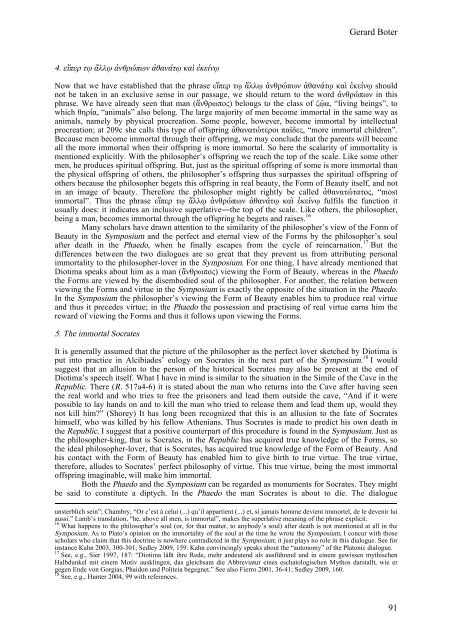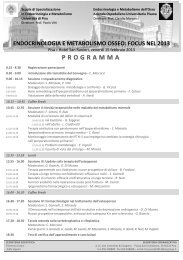Create successful ePaper yourself
Turn your PDF publications into a flip-book with our unique Google optimized e-Paper software.
4. εἴπερ τῳ ἄλλῳ ἀνθρώπων ἀθανάτῳ καὶ ἐκείνῳ<br />
Gerard Boter<br />
Now that we have established that the phrase εἴπερ τῳ ἄλλῳ ἀνθρώπων ἀθανάτῳ καὶ ἐκείνῳ should<br />
not be taken in an exclusive sense in our passage, we should return to the word ἀνθρώπων in this<br />
phrase. We have already seen that man (ἄνθρωπος) belongs to the class of ζῷα, “living beings”, to<br />
which θηρία, “animals” also belong. The large majority of men become immortal in the same way as<br />
animals, namely by physical procreation. Some people, however, become immortal by intellectual<br />
procreation; at 209c she calls this type of offspring ἀθανατώτεροι παῖδες, “more immortal children”.<br />
Because men become immortal through their offspring, we may conclude that the parents will become<br />
all the more immortal when their offspring is more immortal. So here the scalarity of immortality is<br />
mentioned explicitly. With the philosopher’s offspring we reach the top of the scale. Like some other<br />
men, he produces spiritual offspring. But, just as the spiritual offspring of some is more immortal than<br />
the physical offspring of others, the philosopher’s offspring thus surpasses the spiritual offspring of<br />
others because the philosopher begets this offspring in real beauty, the Form of Beauty itself, and not<br />
in an image of beauty. Therefore the philosopher might rightly be called ἀθανατώτατος, “most<br />
immortal”. Thus the phrase εἴπερ τῳ ἄλλῳ ἀνθρώπων ἀθανάτῳ καὶ ἐκείνῳ fulfils the function it<br />
usually does: it indicates an inclusive superlative―the top of the scale. Like others, the philosopher,<br />
being a man, becomes immortal through the offspring he begets and raises. 16<br />
Many scholars have drawn attention to the similarity of the philosopher’s view of the Form of<br />
Beauty in the <strong>Symposium</strong> and the perfect and eternal view of the Forms by the philosopher’s soul<br />
after death in the Phaedo, when he finally escapes from the cycle of reincarnation. 17 But the<br />
differences between the two dialogues are so great that they prevent us from attributing personal<br />
immortality to the philosopher-lover in the <strong>Symposium</strong>. For one thing, I have already mentioned that<br />
Diotima speaks about him as a man (ἄνθρωπος) viewing the Form of Beauty, whereas in the Phaedo<br />
the Forms are viewed by the disembodied soul of the philosopher. For another, the relation between<br />
viewing the Forms and virtue in the <strong>Symposium</strong> is exactly the opposite of the situation in the Phaedo.<br />
In the <strong>Symposium</strong> the philosopher’s viewing the Form of Beauty enables him to produce real virtue<br />
and thus it precedes virtue; in the Phaedo the possession and practising of real virtue earns him the<br />
reward of viewing the Forms and thus it follows upon viewing the Forms.<br />
5. The immortal Socrates<br />
It is generally assumed that the picture of the philosopher as the perfect lover sketched by Diotima is<br />
put into practice in Alcibiades’ eulogy on Socrates in the next part of the <strong>Symposium</strong>. 18 I would<br />
suggest that an allusion to the person of the historical Socrates may also be present at the end of<br />
Diotima’s speech itself. What I have in mind is similar to the situation in the Simile of the Cave in the<br />
Republic. There (R. 517a4-6) it is stated about the man who returns into the Cave after having seen<br />
the real world and who tries to free the prisoners and lead them outside the cave, “And if it were<br />
possible to lay hands on and to kill the man who tried to release them and lead them up, would they<br />
not kill him?” (Shorey) It has long been recognized that this is an allusion to the fate of Socrates<br />
himself, who was killed by his fellow Athenians. Thus Socrates is made to predict his own death in<br />
the Republic. I suggest that a positive counterpart of this procedure is found in the <strong>Symposium</strong>. Just as<br />
the philosopher-king, that is Socrates, in the Republic has acquired true knowledge of the Forms, so<br />
the ideal philosopher-lover, that is Socrates, has acquired true knowledge of the Form of Beauty. And<br />
his contact with the Form of Beauty has enabled him to give birth to true virtue. The true virtue,<br />
therefore, alludes to Socrates’ perfect philosophy of virtue. This true virtue, being the most immortal<br />
offspring imaginable, will make him immortal.<br />
Both the Phaedo and the <strong>Symposium</strong> can be regarded as monuments for Socrates. They might<br />
be said to constitute a diptych. In the Phaedo the man Socrates is about to die. The dialogue<br />
unsterblich sein”; Chambry, “Or c’est à celui (...) qu’il appartient (...) et, si jamais homme devient immortel, de le devenir lui<br />
aussi.” Lamb’s translation, “he, above all men, is immortal”, makes the superlative meaning of the phrase explicit.<br />
16 What happens to the philosopher’s soul (or, for that matter, to anybody’s soul) after death is not mentioned at all in the<br />
<strong>Symposium</strong>. As to Plato’s opinion on the immortality of the soul at the time he wrote the <strong>Symposium</strong>, I concur with those<br />
scholars who claim that this doctrine is nowhere contradicted in the <strong>Symposium</strong>; it just plays no role in this dialogue. See for<br />
instance Kahn 2003, 300-301; Sedley 2009, 159. Kahn convincingly speaks about the “autonomy” of the Platonic dialogue.<br />
17 See, e.g., Sier 1997, 187: “Diotima läßt ihre Rede, mehr andeutend als ausführend und in einem gewissen mythischen<br />
Halbdunkel mit einem Motiv ausklingen, das gleichsam die Abbreviatur eines eschatologischen Mythos darstallt, wie er<br />
gegen Ende von Gorgias, Phaidon und Politeia begegnet.” See also Fierro 2001, 36-41; Sedley 2009, 160.<br />
18 See, e.g., Hunter 2004, 99 with references.<br />
91




